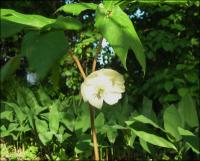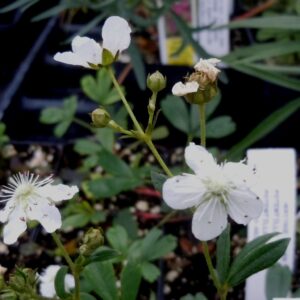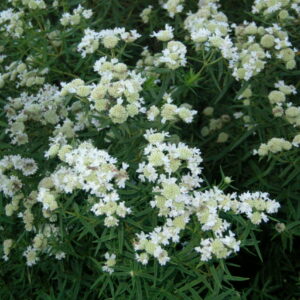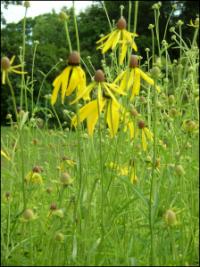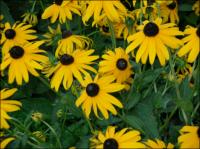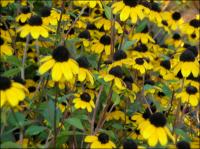Wisconsin Native
Showing 73–80 of 107 results
-
Podophyllum peltatum Mayapple, Hog apple, Mandrake Z 4-9
Nodding, waxy, 6-9-petaled, white cup-shaped flowers with yellow stamens, bloom in spring. Flowers shaded by umbrella-like leaves. Ephemeral, dies back in summer.
Nodding, waxy, 6-9-petaled, white cup-shaped flowers with yellow stamens, bloom in spring. Flowers shaded by umbrella-like leaves. Ephemeral, dies back in summer.
Size: 18" x 4' spreading by rhizomes
Care: moist well-drained soil in full to part shade; drought tolerant
Native: Quebec to Minnesota, south to Florida & Texas, Wisconsin native
Wildlife Value: attracts bumblebees. Walnut tolerant, resistant to deer and rabbits.Named by botanists for its supposed resemblance to a duck’s foot (Anapodophyllum.) Its common name from the small green, apple-shaped seed pod that emerges in May, after flowering. Although its roots, seeds, and leaves are poisonous, Mayapple root used medicinally by Native Americans – for the Iroquois & Delaware as a laxative and purgative, to purify the body and expel worms. Cherokee and Menomonee made the root’s juice into insecticide to protect corn and potatoes from insects. Oneidas made a poltice for sores – cut every joint of root & bake half a day until brown then add water. Roots also used by Native Americans and early settlers as a purgative, emetic, “liver cleanser,” worm expellant, and to remedy jaundice, constipation, hepatitis, fever, and syphilis. Introduced 1664. You can hunt Morel mushrooms when Mayapples bloom.
-
Polemonium reptans Greek valerian, Jacobs ladder Z 3-8
Opposite leaves grow up the foot-tall stems forming a ladder to the tops where sprays of five-petaled lavender-blue bells with bright yellow stamens, bloom in spring. Repeats if deadheaded and may self-sow if not cut back.
Opposite leaves grow up the foot-tall stems forming a ladder to the tops where sprays of five-petaled lavender-blue bells with bright yellow stamens, bloom in spring. Repeats if deadheaded and may self-sow if not cut back.
Size: 8-12” x 10”
Care: part shade in moist to moist well-drained soil
Native: Ontario & Quebec to Alabama, west to MN & KS, Wisconsin native
Wildlife Value: attracts bees, butterflies and wasps. Tolerates walnut, resists deer.Polemonium is Greek meaning “to wage war,” “on account of the contests, which arose betwixt two princes, each assuming the honour of the discovery of it to himself.” Gardeners Dictionary, 1768. Meskwaki made a compound of roots of this plant as a physic and urinary problem remedy. Collected for gardens before 1750.
-
Polygonatum biflorum Solomon’s seal syn. P. commutatum Z 3-9
Small white bells dangle from the arching stems in June followed by black fruit of berries.
Small white bells dangle from the arching stems in June followed by black fruit of berries.
Size: 2-5’ x 2’
Care: shade in well-drained soil. Good dry shade plant.
Native: So. Canada and northern U.S., WisconsinDioscorides named Polygonatum in the 1st century, which means “many jointed” referring to scars on the rhizome. Used medicinally by the Cherokee, Chippewa and Menominee for dysentery, stomachaches, breast and lung disease and for “general debility.” It put Chippewa to sleep but revived unconscious Menominee. HoChunk added cooked and dried root to soups. Lakota Sioux: “The rhizomes are een soups and stews. They are also dried for later use. The young shoots can be eaten raw or cooked but seeds and fruits are considered toxic.” P. biflorum grown in American gardens since 1700’s.
-
Potentilla tridentata syn. Sibbaldiopsis tridentate Three-toothed cinquefoil Z 2-7
Clusters of white, single rose-like saucer flowers spring and early summer on this dainty-appearing perennial. Its glossy evergreen leaves tinge red in fall and winter.
Clusters of white, single rose-like saucer flowers spring and early summer on this dainty-appearing perennial. Its glossy evergreen leaves tinge red in fall and winter.
Size: 6" x 12" spreading by runners-can become a groundcover.
Care: sun in well-drained to moist well-drained acidic soil.
Native: New England to Upper Great Lakes, north to the Arctic, Appalachian Mountains of Georgia, Wisconsin native.
Awards: Cary Award Distinctive Plants for New EnglandDescribed by Kew’ Botanic Garden’s 1st botanist William Aiton (1731-1793) Hortus Kewensis vol 2 p. 216 (1789), who wrote that it came from Benjamin Bewick’s “curious botanic garden” in Clapham. Introduced it in 1776.
-
Pycanthemum virginianum Mountain mint Z 4-8
Corymbs of numerous pinkish-white blossoms, leaves fragrant.
Corymbs of numerous pinkish-white blossoms in August, leaves fragrant.
Size: 3' x 18"
Care: full sun to part shade in moist well-drained to well-drained soil
Native: Wisconsin native, Eastern U.S.
Wildlife Value: attracts butterflies, supports over 50 bee species.Named by Linnaeus in 1753. Pycanthemum is Greek meaning “dense blossom.” Chippewa used it to stop menstrual flow, cure chills and fever and to season meat. The plant gave the Meskwaki energy and lured minks into their traps. Lakota Sioux: “The leaves make a very pleasant tea. An infusion of the plant is taken for coughs.” Grown at America’s 1st botanic garden, Elgin Botanic Garden 1811
-
Ratibida pinnata Prairie coneflower Z 3-8
Skirt of drooping, sunny, thin petals surround erect brown cone on this fragrant flower, smelling of anise, June-August.
Skirt of drooping, sunny, thin petals surround erect brown cone on this fragrant flower, smelling of anise, June-August.
Size: 4' x 18"
Care: sun to part shade in any soil
Native: Ontario, VT to FL, SD to OK, Wisconsin native
Wildlife Value: Butterfly plant. Birds eat seeds.Pinnata means feathery in Latin referring to the thin petals of the flower. Native Americans cured toothaches with the root & made tea from the cone and leaves. Collected by French plant hunter André Michaux (1746-1802) on the prairies of Illinois in 1795.
-
Rudbeckia subtomentosa Sweet coneflower Z 4-8
These Rudbeckias tower above basal leaves on rigid, branching stems forming clumps of sun yellow petaled flowers surrounding a raised, brown-purple dome of disc flowers.
These Rudbeckias tower above basal leaves on rigid, branching stems forming clumps of sun yellow petaled flowers surrounding a raised, brown-purple dome of disc flowers.
Size: 4-5' x 1-2'
Care: Sun to part shade in moist to moist well-drained soil
Native: East US, Wisconsin native.
Wildlife Value: attracts butterflies, deer resistantRudbeckia was named by Linnaeus for his University of Upsala professor, Olaf Rudbeck. Rudbeck made the surprising claim “that the Paradise of Scripture was situated somewhere in Sweden.” C.F. Level. This species described in 1815. May have been collected by English planthunter John Bradbury (1768-1823).
-
Rudbeckia triloba Branched coneflower, Brown eyed susan Z 3-9
Multitudes of stems, each bearing a small sunny daisy with brown centers at its tip for a sun-drenched crowd from July to October, as cheery as they come.
Multitudes of stems, each bearing a small sunny daisy with brown centers at its tip for a sun-drenched crowd from July to October, as cheery as they come.
Size: 3-4' x 2-3'
Care: sun to part shade in moist well-drained to well-drained soil
Native: most of North America, Wisconsin native
Wildlife Value: Numerous bees, some flies, a few wasps and butterflies feed on the nectar and pollen. One bee feeds only on Rudbeckias and Ratibida flowers.
Awards: Georgia Gold Medal winner. England’s Royal Horticultural Society Award of Garden Merit.Rudbeckia was named by Linnaeus for his University of Upsala professor and founder of the Uppsala botanic Garden, and his son, University of Uppsala professor named Olaf Rudbeck. This species collected in Colonial Virginia in 1600’s.

